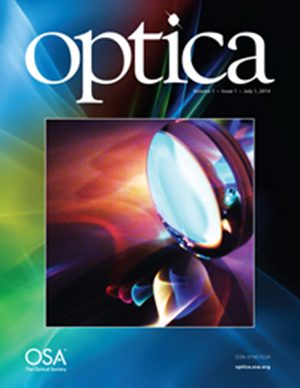Sculpting harmonic comb states in terahertz quantum cascade lasers by controlled engineering
IF 8.4
1区 物理与天体物理
Q1 OPTICS
引用次数: 0
Abstract
Optical frequency combs (OFCs), which establish a rigid phase-coherent link between the microwave and optical domains of the electromagnetic spectrum, are emerging as key high-precision tools for the development of quantum technology platforms. These include potential applications for communication, computation, information, sensing, and metrology and can extend from the near-infrared with micro-resonator combs, up to the technologically attractive terahertz (THz) frequency range, with powerful and miniaturized quantum cascade laser (QCL) FCs. The recently discovered ability of the QCLs to produce a harmonic frequency comb (HFC)—a FC with large intermodal spacings—has attracted new interest in these devices for both applications and fundamental physics, particularly for the generation of THz tones of high spectral purity for high data rate wireless communication networks, for radio frequency arbitrary waveform synthesis, and for the development of quantum key distributions. The controlled generation of harmonic states of a specific order remains, however, elusive in THz QCLs. Here, and by design, we devise a strategy to obtain broadband HFC emission of a pre-defined order in a QCL. By patterning n regularly spaced defects on the top surface of a double-metal Fabry–Perot QCL, we demonstrate harmonic comb emission with modes spaced by an (n + 1) free spectral range and with an optical power/mode of {\sim}{270}\;\unicode{x00B5} {\rm W}.通过受控工程雕刻太赫兹量子级联激光器中的谐波组合态
光频梳(OFC)在电磁波谱的微波和光学领域之间建立了刚性相干联系,正在成为量子技术平台开发的关键高精度工具。这些技术包括通信、计算、信息、传感和计量方面的潜在应用,并可通过微谐振梳从近红外扩展到具有技术吸引力的太赫兹(THz)频率范围,以及功能强大的小型化量子级联激光器(QCL)。最近发现的量子级联激光器产生谐波频率梳(HFC)的能力--具有大模态间距的FC--引起了人们对这些器件在应用和基础物理学方面的新兴趣,特别是在为高数据速率无线通信网络生成高光谱纯度的太赫兹音调、射频任意波形合成以及量子密钥分布的开发方面。然而,在太赫兹 QCL 中,受控生成特定阶次的谐波态仍然是个难题。在此,我们设计了一种在 QCL 中获得预定阶宽带 HFC 发射的策略。通过在双金属法布里-珀罗 QCL 的顶面上图案化 nn 个规则间隔的缺陷,我们展示了谐波梳状发射,其模式间隔为 (n + 1n + 1) 个自由光谱范围,光功率/模式为 {\sim}{270}\;\unicode{x00B5} 。{\rm W}{\sim}{270}\;\unicode{x00B5}{rm W}.
本文章由计算机程序翻译,如有差异,请以英文原文为准。
求助全文
约1分钟内获得全文
求助全文
来源期刊

Optica
OPTICS-
CiteScore
19.70
自引率
2.90%
发文量
191
审稿时长
2 months
期刊介绍:
Optica is an open access, online-only journal published monthly by Optica Publishing Group. It is dedicated to the rapid dissemination of high-impact peer-reviewed research in the field of optics and photonics. The journal provides a forum for theoretical or experimental, fundamental or applied research to be swiftly accessed by the international community. Optica is abstracted and indexed in Chemical Abstracts Service, Current Contents/Physical, Chemical & Earth Sciences, and Science Citation Index Expanded.
 求助内容:
求助内容: 应助结果提醒方式:
应助结果提醒方式:


